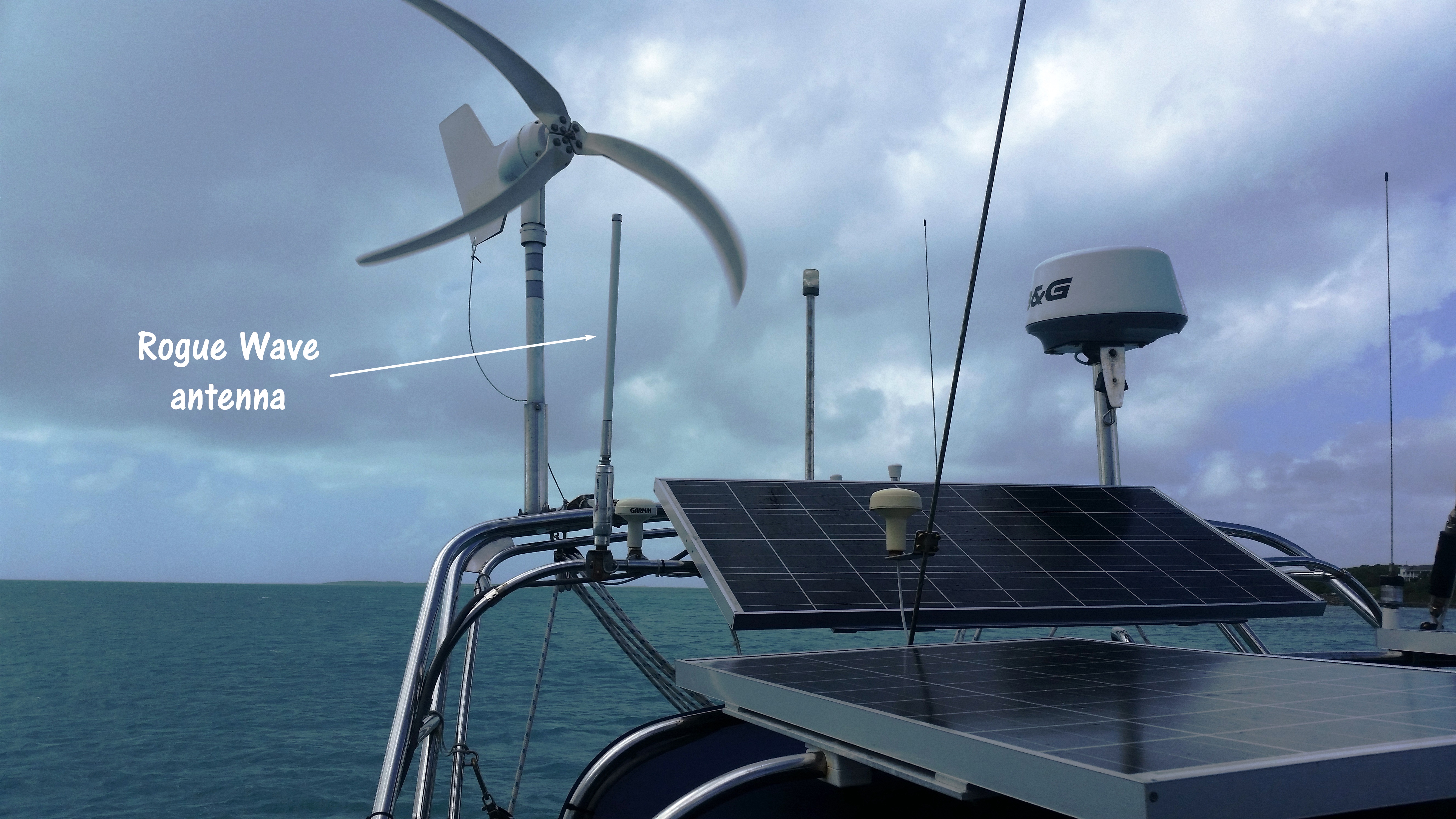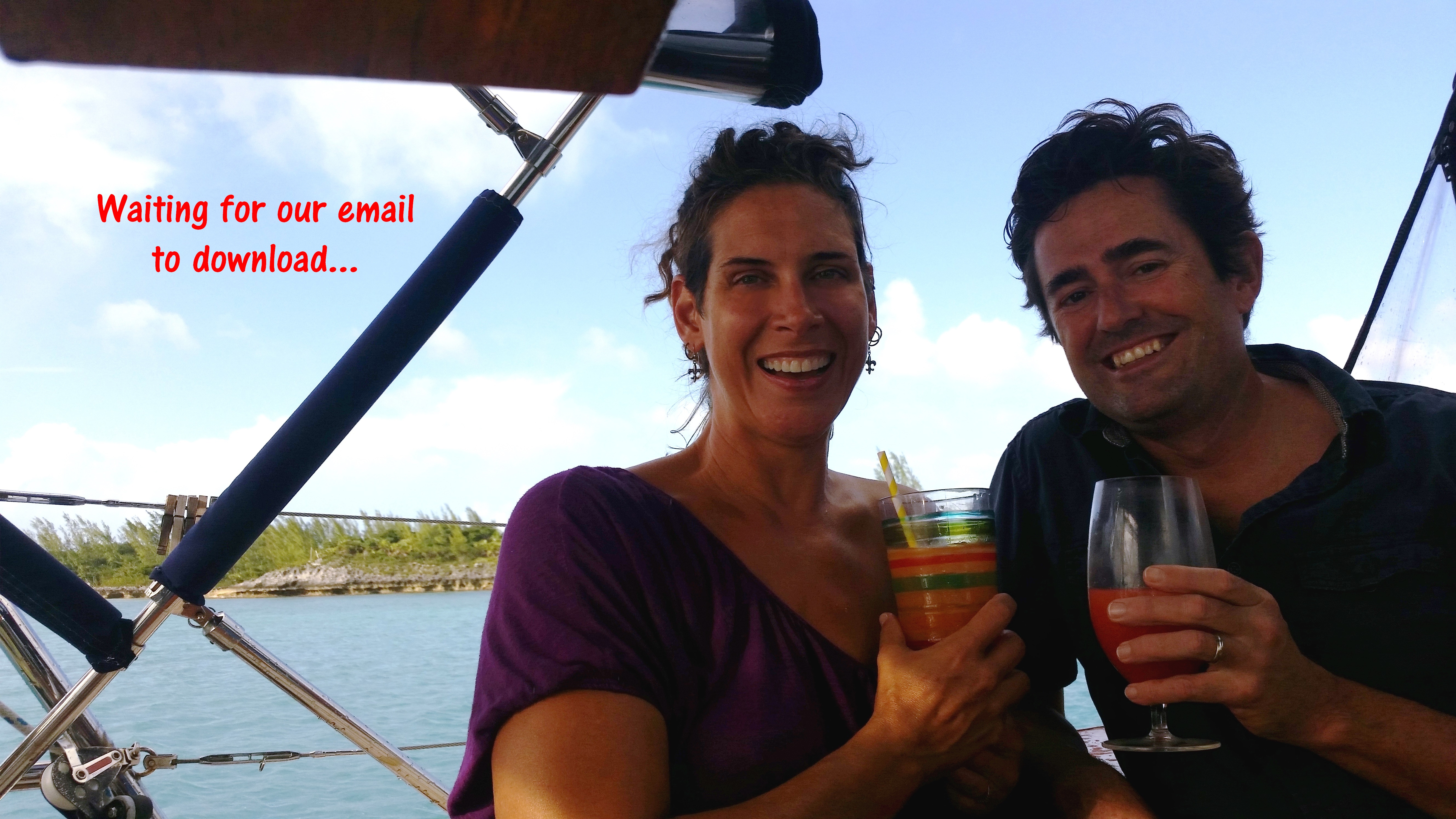For the last two months we’ve been spoiled. Since we arrived in the Bahamas we’ve had mostly reliable (albeit very slow) and reasonably priced access to internet and phone service. We expect that trend to continue while we’re here the next few months, but are aware that it won’t last forever. We’ve made preparations for staying in touch from greater distances, or for those times when there simply is no connectivity. We thought you may be interested to know how we can communicate while underway, and ways to reach out in an emergency.

Phone Calls & Texts
We kept our smart phones. They do so much more than call and text that it was a no-brainer. Using them via WiFi, as you know, is easy. Learning how to get cell service took some investigating. We were Verizon customers, and quickly learned that their international plans would break our bank. T-Mobile, however, recently implemented regular service all throughout the Bahamas and Caribbean for $60 a month. We chose one phone, using my cell number, for this service. On it, we now get unlimited data (it slows down dramatically after 3 gigs) and $0.20/minute calls outside of the U.S. In order to switch our phones to non-Verizon accounts we had to unlock them. That meant paying off the balance of our contract, which would allow our phones to automatically accept a “foreign” SIM card. Our other phone we decided to use with in-country SIM cards for making (we thought) cheaper local calls. Our friends Joaquin and Sofia gave us their gently used Bahamas SIM card that still had some minutes left on it. Once we activated it we found that the only cell company in the Bahamas, BTC, charges $0.30 a minute ($0.15 at night) for calls, and no data! We’re keeping it for emergencies, but the T-Mobile account is a much better deal, at least during the day. In other parts of the Caribbean, local SIM cards may be cheaper. We’ll find out in time. (To those of you who generously donated your old “flip phones” to us for this purpose, I give my thanks. Had we known our own phones would do the trick we wouldn’t have needed to ask for yours. Your phones have been donated to a battered women’s shelter.)
Snail Mail
Although we have almost everything possible sent to us electronically, to our chagrin, there is no way to completely avoid paper mail. Luckily, there are companies that cater to cruisers that can arrange to get mail to you in a couple of ways. We chose St. Brendan’s Isle because of their reputation among cruisers and RV-ers for handling not only mail, but officially and legally representing you in driver’s license renewals and absentee voter ballots, all in a proficient manner. For a fee, they will scan all envelopes addressed to you, and either open them and scan the contents, trash them, or forward them to you. Most of our correspondence is done via email now, but some things (like our dive master certification cards) must be forwarded.
Internet
Since one phone has a data plan we can access the internet from there, but what a pain it is! Using our laptop is so much more convenient, but connecting it to the interweb on a boat isn’t as easy as plugging in a cord from your cable company. Months ago we installed a high-powered, long-range WiFi antenna, a Rogue Wave. It allows us to log into a WiFi hotspot from up to seven miles away, within line of sight (but the closer, the better). If the hotspot is not encrypted, voila! Otherwise, we have to find the source, usually a bar or marina that will give you the password if you spend a few bucks with them. If all that fails, there is a pay-as-you-go WiFi hotspot service throughout the Bahamas for $20 per week, but it is painfully slow. Once we have a WiFi connection, we create an internal hotspot on board with a miniature wireless router. As long as we are near a population center, we can usually get reception. Because of our preference for remote anchorages, however, we often find ourselves with no internet at all, or with a connection that resembles the speeds of early 1990’s dial-up modems (look it up, kids).
Email
Obviously, when we have internet, we have email, but what about when we don’t have that elusive WiFi connection? We can still get emails, but only in message form – no photos or documents – using our single sideband radio (SSB). Even though the technology is decades old, SSB is a goldmine. Using old fashioned high frequency radio waves, we can receive data in many forms, one of which being email. Because the signal is so strong, using SSB to transmit requires a station license from the Federal Communications Commission (FCC). Through a paid service called Sail Mail, we can send and receive typed messages over their email server. It takes a while to send the data, so the shorter, the better, but it’s here all day, every day should we need it. Choosing which of the many worldwide stations to try to call requires some black magic called “sky wave propagation analysis”; but fortunately there is software to assist us with this.
Radio Communications
That same SSB that accesses email can be used for long-distance voice communications (ship-to-ship or ship-to-shore), reaching thousands of miles in the right conditions. There are several “nets” that cater to cruisers, which broadcast on a daily schedule. All you have to do is tune in at the correct time to get news and weather, or just to hear what cruisers are up to in other parts of the world. In some cases you’re free to chime in. However, you cannot use SSB to simply call out to someone without a prearranged station and time. For shorter range voice communications we have several VFH radios onboard. These we use for calling other people on boats or ashore. The radios stay tuned to channel 16, which is the international hailing and emergency channel. Once you reach your party, you switch to a different channel to continue your conversation. It’s like a party-line, though, so anyone can listen in on your convo. We have a handheld, cordless unit that we take with us when going out in our dinghy.
Weather
That magical SSB radio can be used to download weather data. Using the Sail Mail program that I mentioned above, we can pinpoint the exact area(s) for which we need a forecast, and it gets sent to our computer. You can specify whether you want a general synopsis, a weather map or both.
Texting Offshore
When we are out of cell phone range we can still send and receive text messages using our Delorme InReach two-way satellite communicator and tracker. For $27 per month we can send and receive short messages. We also use this device to track our passages. If you go to the “Where is Pura Vida?” link above, or the mapshare page, you can see how it notes where we are and where we’ve been. We have it set to update every 10 minutes when we’re moving, so our location is quite current.
Emergency Contact
That same Delorme offers 24/7 search and rescue support if we should activate the SOS alarm. If we should ever need to deploy our life raft, taking this little device with us will make our location known to rescuers and allow us to text back and forth with a rescue operations center. On top of this, we also have an emergency position indicating radio beacon. This EPIRB lives in our “ditch bag”, and automatically sends a locating signal when it gets submerged, or we flip the switch. EPIRB signals are monitored by governments and international agencies worldwide and relayed to the closest vessels in the area to assist.
So, there you have it! If you need us, there are many ways to reach us, Of course, we’d prefer to talk to you face-to-face, so, when are you coming to join us???

Thanks for the article, lots of good information. we are on a countdown ourselves, I’ll be heading out in June, leaving from Mandeville, sure you will be well south by then.
Thomas, congrats and best of luck casting off the lines and sailing away. Do you have a blog? What is your vessel so we keep an eye out for you. We’re not sure where we will be in June, we might only be as far as the Dominican Republic or PR. Or who knows, we might stay in the southern Bahamas longer.
no blog, just me and the Family and boat, I have a Beneteau 46, “Ida Claire” she is pretty well equipped , more stuff than I know how to use! Hopefully kids get out of school and we are gone. we’ll see how far we make it. Until then I’ll live thru y’all .
How is tmobile coverage in the outisland and southren bahamas? Currently using them in they keys and love it. Heading that way next spring.
We have only traveled the Abacos and Berry Islands so far. We found the coverage to be great in the Abacos because you are almost always near a BTC tower. The Berrys are a different story, very spotty to non-existent coverage unless you are close to Chub Cay.